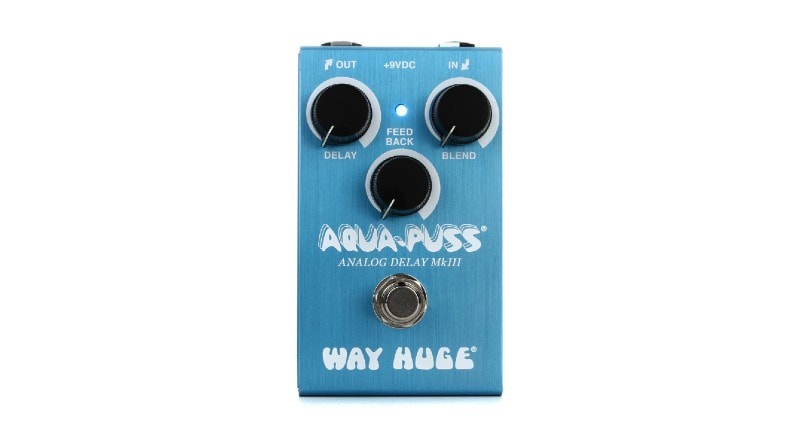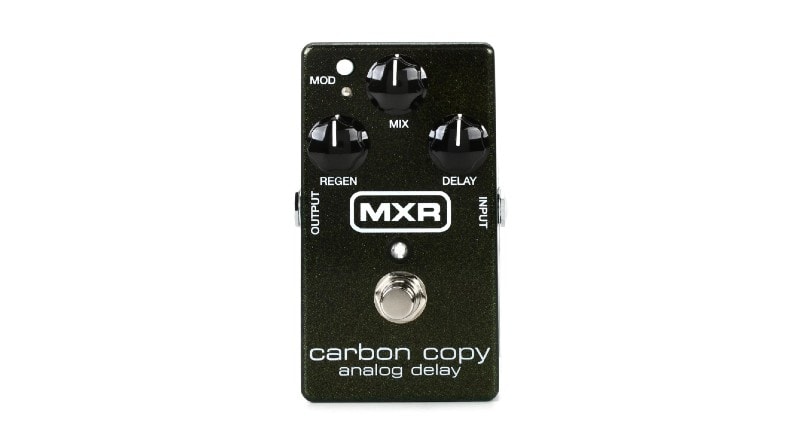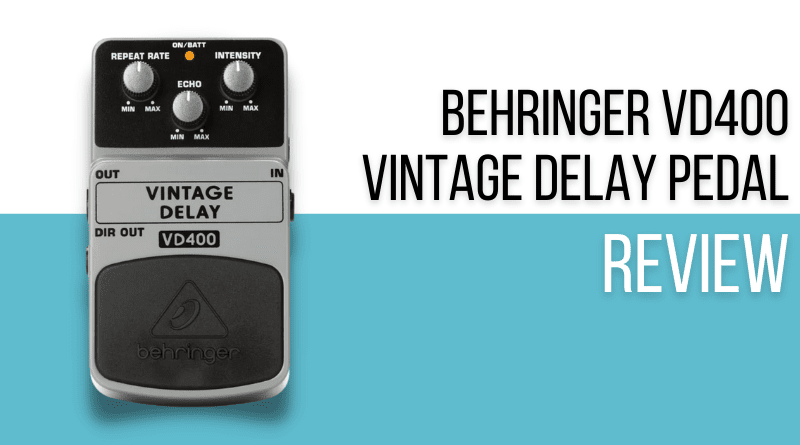Not only is Behringer’s ever expanding range of pedals a great way to get budget versions of some of the most popular models on the market, but they also provide a way for guitarists to get hold of equivalents to popular, but now-discontinued models from years gone by.
The Behringer VD400 is a classic example. Like the rest of the Behringer line, it’s inexpensive, and as It’s inspired by the Boss DM-3 (a classic pedal that was produced for a short time in the 80s), it has a familiar layout, but the real question is, can the VD400 Vintage Delay get you the same (or better) results? Read on to see what we found.
Read more about our review process.
Contents
Behringer VD400: Who Is This Pedal For?
The Behringer VD400 Vintage Delay is aimed at new and experienced players alike. Of course, the low price does make this pedal an appealing prospect to newer players, or more accurately players who are new to the world of standalone FX.
Despite the fact that this pedal is primarily aimed at the budget conscious beginner, the feature set and familiar layout of the VD400 Vintage Delay definitely calls out to more experienced players who might be looking to create a particular sound without overpaying for a used pedal.
Behringer VD400: Appearance / Features / Controls
If you’re at all familiar with Behringer’s pedal line, you’ll no doubt be aware that they are (notoriously) made with a plastic shell. If you’ve never physically handled one of them, you’re likely to be in for a pleasant surprise. Despite the plastic construction the VD400 Vintage Delay is actually rather sturdy. It won’t survive rough handling and mistreatment the way that metal pedals do, but if you’re careful with your gear, there is no reason you couldn’t gig with one of these pedals.
Rather than matching everything from the inspiration for this pedal (the Boss DM-3 was finished in red), down to the color scheme, Behringer has finished the Vintage Delay in a battleship gray tone.
As for layout, this pedal has a simple 3 dial control setup (again, like the DM-3), that includes repeat rate, echo, and intensity, each ranging from min to max. The repeat rate controls the time between the note you play and when the pedal repeats it (measured in milliseconds). Echo controls the trail off, which will impact whether you hear the delay as a soft echo, or a clear repeat of the original note. Finally, intensity controls the number of repeats the pedal creates.
Interestingly, this pedal has 3 jack sockets, compared to the usual 2. Of course, there’s line in and line out, but as with the pedal that this is modeled after, there is also a direct out, which allows for a clean signal and an affected signal to leave the pedal simultaneously, both of which can be plugged into 2 separate amps to create something known as the wet/dry effect.
Behringer VD400: Performance / Sound
We started off by installing a battery into the VD400. Fortunately, this not being the first Behringer pedal we’ve reviewed, we were able to do this quite quickly. For a beginner, this might actually cause some issues as to open it up, you need to simultaneously depress 2 recessed buttons with screwdrivers (or another appropriately sized implement). Regardless, definitely an area for improvement.
Once we were powered up, the test started with the straight line in, line out setup, using no other FX. We found the control layout to be intuitive, in fact, even more so than the Boss version. On the Boss, the repeat rate goes higher with a counter clockwise turn and lower with a clockwise turn. On the Behringer it’s a more familiar counter clockwise for lower, clockwise for higher.
The repeat rate on offer for this pedal is 20ms to 300ms. This isn’t the biggest range of any pedal on the market, but it’s definitely sufficient for most use cases. If you’re looking to get really experimental, you might need to look at the alternative pedals below for models with bigger repeat rates.
To check out the average sound from the VD400, we set everything to noon. This gave a great mid point picture of the sound quality. We noted that it was warm, and very analog sounding. It wasn’t exactly a convincing tape delay, but it sounded great regardless.
Turning the echo down resulted in a very sharp, almost stunted delay, which definitely took the warmth out of the tone. Not only that, with the echo down, background noise became much more noticeable. With the echo up we got the rounded sound we were looking for from this pedal, and less observed fizz.
The intensity dial was used to great effect. With this dial maxed out we managed to get huge sustain, and with it rolled back we were able to kill the sound quickly and keep things clear and punchy.
We absolutely had to try the wet/dry sound, so we kept the line out running to a Bugera V22, but then sent the direct out to our new Stage Right 5w all tube practice amp. With this setup we ended up with a great ping pong stereo effect that sounded way different to the pedal alone – if this is something you’re able to try, we definitely recommend doing so.
Other Vintage Delay Pedals to Consider
If the specs on the Behringer VD400 Vintage Delay aren’t to your liking, there are some great alternatives on the market that might hit the spot.
Boss DM-2W Waza Craft Delay Pedal

This model is from the Premium Waza Craft line from Boss. Using the best of the best in components and construction, this pedal is packed with features. It offers a standard mode, which produces a dark, atmospheric tone, and it also allows for custom modes, with delay times of up to 800ms.
Way Huge Smalls Aqua Puss

This is one of the coolest delay pedals on the market. It offers simple operation, and it’s capable of producing some of the most authentic sounding tape style delay of any pedal. This pedal makes it easy to add color to a mix without swamping it. Like the Behringer, it offers up to 300ms of delay time, which is often all a player needs.
MXR M169 Carbon Copy

This MXR stompbox uses vintage style circuitry to achieve an authentic analog tone and boasts up to 600ms of delay time. Controls are easy to master, and for advanced players, it contains internal trim pots in order to allow for adjustment of width and rate control beyond the base settings on the dials.
Final Thoughts on the Behringer VD400
Behringer’s success lies in simplicity. They have once again produced a quality pedal, and they’ve done so without trying to reinvent the wheel. The VD400 Vintage Delay has the features and tones that players loved, and now miss, from the DM-3 at a simply unbeatable price. It looks great on the pedalboard, and there’s no good reason not to add one to your collection!
Check out these other articles you might like:


